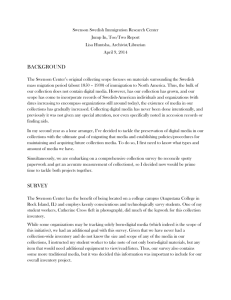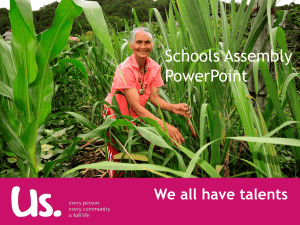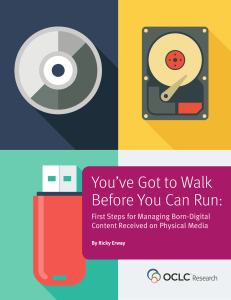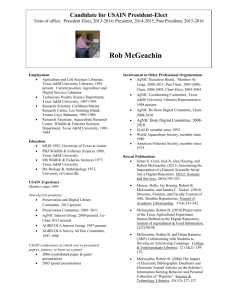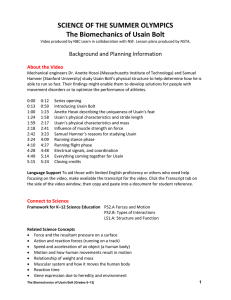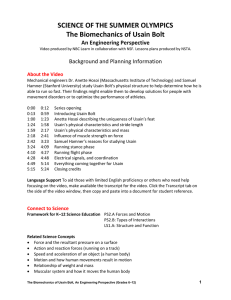Oct. 2008 Born-digital Extension Publications Project
advertisement
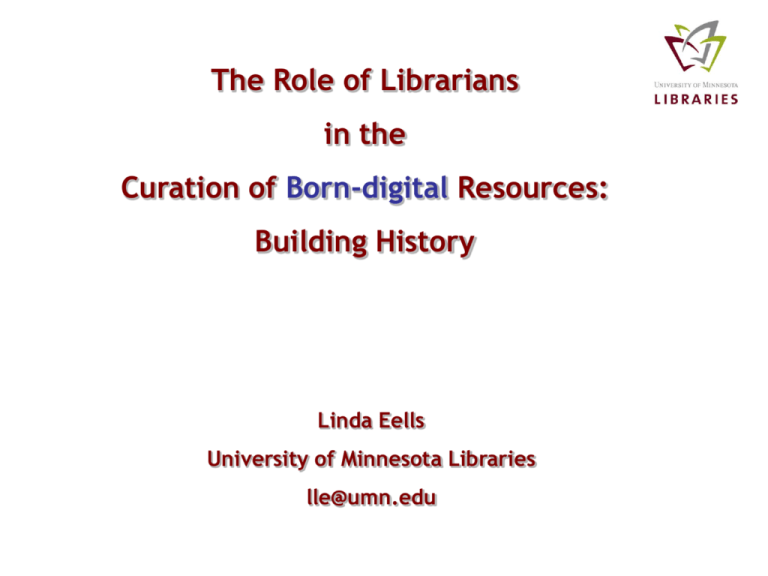
The Role of Librarians in the Curation of Born-digital Resources: Building History Linda Eells University of Minnesota Libraries lle@umn.edu Getting “Into the flow…” Personalized portals, push technology, affinity strings and faceted searches “Advance the Libraries' transition from print to digital collections, fostering cooperative action toward a new model of collection management and increasing the visibility of and access to our rich array of resources. “ e Science initiativesnational and local and Collaborations for greater access Access to Digital Content ►“Current” resources – We’re good ►Historical content (Reborn digital) – Getting better ►Born-digital content 10 (or 50) years from now - ??? Current content Historical (Reborn digital) content National Preservation Program for Agricultural Literature A National Endowment for the Humanities supported project of USAIN (United States Agriculture Information Network.) • Preserve and provide access to agricultural literature published prior to 1950 • Twenty-seven states in first five phases • MN – 350 titles, ~3,000 volumes NAL/land-grant universities Microfilming Project Early 1980s - microfilmed older Minnesota Agricultural Experiment Station, Agricultural Extension Service, and some academic department publications, including both monographs and serials Cornell >1,900 books 6 journals >850,000 pages The Problem: Long-term access to Born-digital Resources “In a better world, high-quality, peer-reviewed information would be • freely available soon after its creation; it would be • digital by default, but optionally available in print for a price; it would be • easy to find, and it would be • available long after its creation, at a stable address, in a stable form.” -Unsworth and Yu 2003 The Problem: LINK ROT The percentage of inactive Internet references increased from 3.8% at 3 months to 13% at 27 months after publication Inactive Internet references .com addresses - 46% lost after 27 months .edu (30%) other (20%) .gov (10%) .org (5%) -Dellavalle et.al. 2003 46% of all citations to Web-located sources could not be accessed HTTP 404 (Page not found) message (61.5%) being the greatest cause of missing citations. Collectively, the missing citations accounted for 22.0% of all citations -Sellitto 2005 Born-digital Extension Publications Project Mission A group of land-grant institutions, in partnership with AgNIC, ADEC, USAIN, NAL, and others, and with strong (and critical) support from institutional Colleges of Agriculture and/or Natural Resources and Cooperative Extension Service units, propose to collaboratively create policies, determine appropriate standards, and develop the technical infrastructure for a repository of born digital, and subsequently reborn digital, agricultural resources that may be readily scaled to involve other national and international partners (e.g. eXtension, FAO). Key Concepts • Phased approach • Scalable • Compliant with national/international standards • Persistent long-term access • Secure • Openly accessible • Collaborative content development • Sustainable deposition/description Born-digital Extension Publications Project Steering Committee - Institutional Members • Colorado State University • Cornell University • Ohio State University • Purdue University • Texas A&M • University of Arizona • University of Florida • University of Minnesota (Lead, Phase I) Advisory group composition (suggested) • USAIN liaison • AgNIC & NAL liaison (Melanie Gardner) • ADEC liaison (Janet Poley) • Tribal college and/or 1890s U representative • NASULGC representative • IT expertise Task Forces: Phase I • Pilot Institution Selection Establish criteria (e.g. functioning IR, strong formal Extension & Libraries commitment), evaluate, and identify Phase I pilot project institutions • Grant funding - source assessment and identification Research possible funding agencies, map their goals/mission to the mission of this project, and pursue contacts (to gauge potential interest in this type of project). • Planning Grant/Policy Development Draft planning grant and guide submission of proposal. Establish selection criteria (collection development policy), articulate copyright policies and permissions form(s), develop work flow templates, etc. • Infrastructure liaison group Serve as institutional liaisons between pilot institutions and AgNIC, ADEC, and others as needed, to ensure the development of metadata standard(s) and an operating infrastructure compatible with capabilities and existing infrastructure at pilot institutions. Full membership will by necessity include IT expertise at pilot institutions and appropriate Advisory group members. Next Steps 1) Steering Committee Meeting at USAIN 2008 a) Review & finalize Phase I parameters b) Review & finalize Task Force descriptions & goals c) Determine Task Force membership d) Determine Advisory Group membership e) Establish timeline for follow-up 2) Task Forces develop full charters and timelines 3) Task Forces complete preliminary agendas and report on progress – Oct. 2008 Born-digital Extension Publications Project …”digital information isn’t going to be easy to find…at a stable address in a stable form unless it is held by libraries – and yet, libraries do not hold most of the digital information…important to scholarship. It is out there in the wild, on the Web, not collected or preserved.” -Unsworth and Yu 2003 “The average lifespan of a Web page today is 100 days. This is no way to run a culture.” -Brewster Kahle, Director and Co-Founder, Internet Archive References Cornell Historical Literature for Agriculture, available at http://chla.library.cornell.edu/c/chla/about.html. (18 April 2008). Dellavalle, Robert P. et.al., 2003. Going, Going, Gone: Lost Internet References, Science 302 (5646): 787. Eells L. 2007. Born-Digital Agricultural Resources: Archives and Issues. Quarterly Bulletin of IAALD, 52(3/4). Gwinn, Nancy, 1993. A National Preservation Program for Agricultural Literature, U.S. Agricultural Information Network. Heatley R. 2007. Plan to Develop a Digital Information Infrastructure to Manage Land Grant Information. Available at http://www.adec.edu/adec-agnic-digital-inf.pdf (5 February 2008). Sellitto, Carmine. 2005. The impact of impermanent Web-located citations: A study of 123 scholarly conference publications, Journal of the American Society for Information Science and Technology 56(7):695-703. Unsworth, John and Pauline Yu. 2003, Not-so-Modest Proposals: What do we want our system of scholarly communication to look like in 2010? CIC Summit on Scholarly Communication, Chicago, December 2, 2003. Available at http://www3.isrl.uiuc.edu/~unsworth/CICsummit.htm (18 April 2008). USAIN Task Force. 2008. Making the Case for a Next-Generation Digital Information System to Ensure America’s Leadership in Agricultural Sciences in the 21st Century. Available at http://www.usain.org/WhitePaperFinal.pdf (1 May 2008). Weiss, Rick. 2003. Electronic Archivists Are Playing Catch-Up in Trying to Keep Documents From Landing in History's Dustbin, Washington Post, November 24, 2003, A08.
